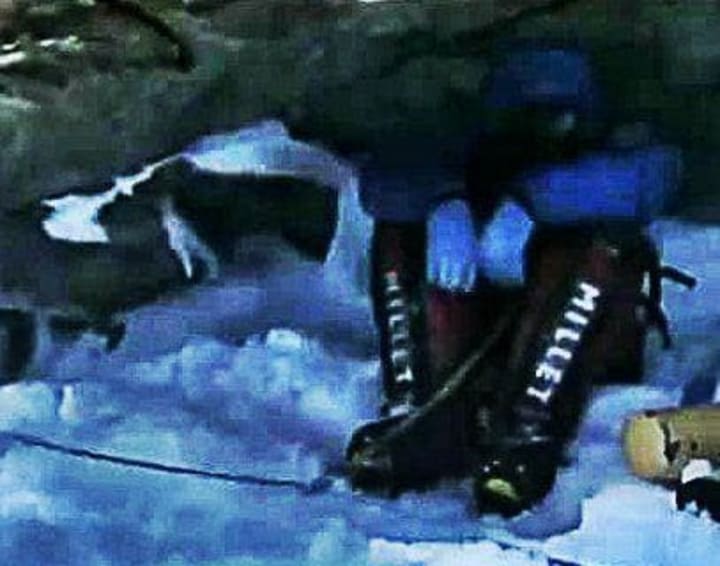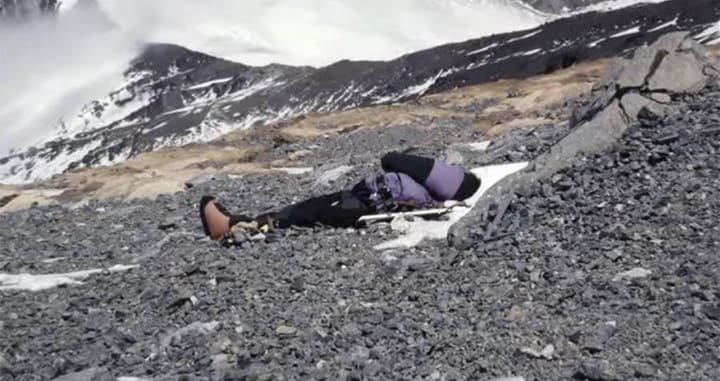Dead Bodies on Mt. Everest & The Death Zone: Summit the Mountain or Die Trying
Over 150 dead bodies lie preserved in the snow on Mt. Everest, serving as permanent reminders of the respect the mountain demands from anyone breaching her peak.

Standing on top of the world. That’s how climbers feel after reaching the peak of Mt. Everest, the tallest mountain in the world standing 29,029 feet above sea level. The peak of Everest is the closest anyone can get to the top of the world.
A Dream Come True
Over 4,000 people have ascended Mt. Everest since 1953 when Sherpa Tenzing Norgay led Edmund Hilary to the peak, becoming the first two people to ever reach the top.. Norgay climbed the mountain without supplementary oxygen tanks, making the accomplishment even more prideful.
Climbers endure weeks of horrendous conditions and put their bodies through extreme conditions for a shot at ascending to the top of Everest. Many do not make it back down the mountain alive, whether they die from the frigid temperatures, health, and medical conditions, or as most climbers, from accidents.
The elevation of the mountain makes recovery of the dead bodies risky and very difficult. As such, many bodies remain on the mountain, used by climbers to determine how close they are to the summit.
The Death Zone
The Death Zone is an area that mountain climbers reach at 26,247-feet elevation. Appropriately named, many of the bodies remaining on the mountain fill the Death Zone, and its the location of most of the deaths.
Extremely dangerous, The Death Zone leaves no room for error. Even standing in the wrong place at the wrong time could be a deadly mistake atop Everest. It’s relentless to climbers, particularly inexperienced trekkers who dare test its dangers.
Climbers can safely spend no more than 48 hours in The Death Zone.
One former climber compared The Death Zone to “running on a treadmill while breathing in a straw.” As climbers ascend the 3,000+ meters to the top, they endure abnormal temperatures and high winds, changes in their body and health, rough terrain, and oxygen levels that deplete by the minute. The consequences to the body from the circumstances cause many hopeful climbers to turn around before they reach the peak -and send many others to the hospital for weeks of recovery after the adventure.
Still, yet, others succumb to the elements and dangers present in The Death Zone. Some climbers fall to their deaths; others die as their bodies succumb to treacherous conditions.
At such high altitudes, the air becomes very thin, offering only about ⅓ of the oxygen we have at sea level. Breathing is difficult, even with complementary oxygen tanks. The cells in the body fight for survival so intensely, they begin to die almost immediately under the circumstances.
The high altitude and thin air may cause disorientation, confusion, and hallucinations, which is scary any time, particularly while high atop a mountain where these problems can lead to poor decision-making skills, leaving climbers to forget to hook a clip properly or even stop midway through the hike. Some climbers even pass out.
Although climbers can prepare for the changes, no one knows exactly how their bodies will react to the changes, and once on the mountain, climbers are at her mercy.
Speaking to PBS, former climber David Carter described the Death Zone as “a living hell.”
Breathing is extremely laborious and difficult and climbers often think of nothing more than their next step. Pulse rate increases, heart rate speeds up trying to carry more oxygen to the muscles and brain and the risk of heart attack or stroke is great.
A common condition experienced by Mt Everest climbers is called high altitude pulmonary edema, or HAPE. This occurs when fluid leaks into the lungs and may cause the climber to pass out, experience difficulty breathing and fatigue, hear a clicking-like noise, and experience a feeling of suffocation, muscle weakness, and cough. HAPE coughing can become so severe with watery or frothy fluid that it breaks the ribs.
Mt. Everest is covered in snow year-round. Its climate is treacherous, particularly in the Death Zone where temperatures never rise above 0 degrees F. Any exposed skin freezes instantly. Frostbite and loss of blood circulation can result in gangrene.
Coupled with the winds that can reach speeds of 30–40 MPH, climbers face dangerous and severe situations in The Death Zone. The most extreme temperature ever recorded on the summit was -56.2 degrees F with wind speeds of 80 m⋅s-1.
Ascending Mt. Everest or Die Trying
Over 300 climbers have died attempting to scale Mt. Everest since 1953. More than half of their bodies remain on the mountain. Bringing down dead bodies is too dangerous for Sherpas and other hikers.
Green Boots

Green Boots, the name given to a climber who died on the mountain, served as a grim reminder of the potential dangers to hikers who passed him on their way to the peak. The location of the body forced most climbers to walk past him on their way up. It’s also a resting spot for many climbers.
In 2014, Green Boots’ body disappeared from its original location near a cave and is one of the bodies climbers see as they hike Everest. The location of the body required almost every hiker to pass him on the way up. The identity of Green Boots is likely a man named Tseqang Paljor who died in 1996, although it’s never been confirmed.
It was revealed later that Chinese Expidentioners moved Green Boots’ body to a less conspicuous location on the mountain.
David Sharp

Sitting inside the corner of the cave with his arms around his knees was another frozen, deceased climber named David Sharp. Attempting a solo summit of Everest, Sharp stopped to rest in the cave beside Green boots and froze to death sitting in the same position after at least 40 people passed by him, not one stopping to offer him any help despite noticing him visibly in obvious distress.
Climbers received criticism for passing by the climber, including from Sir Edmund Hillary, the first man to summit the mountain.
“If you have someone who is in great need and you are still strong and energetic, then you have a duty, really, to give all you can to get the man down, and getting to the summit becomes very secondary,” he told the New Zealand Herald, after news of Sharp’s death broke.
“I think the whole attitude towards climbing Mt Everest has become rather horrifying,” he added. “The people just want to get to the top. They don’t give a damn for anybody else who may be in distress and it doesn’t impress me at all that they leave someone lying under a rock to die.”
Sharp’s body remained on the mountain for about a year until his family requested its removal and paid Sherpas to risk their lives for its removal.
His family requested that Sherpas remove his body the following year.
George Mallory

The body of George Mallory was found on Everest in 1999, 75 years after his 1924 death during a spring hike. His well-preserved body wore a tweed suit and carried primitive equipment. Mallory hoped to become the first person to climb the mountain. No one knows if he achieved the goal.
Hannelore Schmatz

The body of Hannelore Schmatz became a permanent fixture on Everest in 1979. Hannelore was the first woman and first German citizen to die on the mountain. Schmatz died from exhaustion shortly after summiting the mountain.
Despite warnings from her Sherpa, Hannelore set up camp in The Death Zone. She survived a snowstorm overnight and made it almost back down the mountain until she ran out of oxygen. Hannelore also suffered frostbite, resulting in exhaustion. Hannelore died 330 feet from the base camp.
Strong 80 MPH winds blew Hannelore’s body off the mountain or covered it with snow. Until that time, the body sat in plain sight along the Southern Route of the mountain with the brightly colored backpack she carried with her on the trip.
Fran and Sergei Arsentieve

Francys Arsentieve fell during her climb after succumbing to snow blindness. She had somehow gotten separated from her husband, Sergei, who made it back to base. When Fran wasn’t at the base, he went back out to search for her despite being low on oxygen and exhausted. Both were found dead.
Want to Climb Everest?
Expeditions up Mt. Everest are the biggest source of income in Nepal, paying $2,000 — $5,000 (USED equivalent) per season, a low amount considering the risks, but well above the average annual income. Licenses to climb the mountain starts at about $25,000, and expedition companies offer sherpa trips starting at a cost of about $40,000 per person, with no experience in climbing or outdoor survival required.
About the Creator
True Crime Writer
The best of the worst true crime, history, strange and Unusual stories. Graphic material. Intended for a mature audience ONLY.






Comments
There are no comments for this story
Be the first to respond and start the conversation.